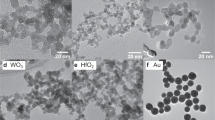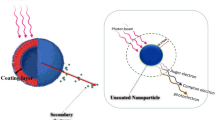Abstract
Nanoparticles with a high atomic number are of interest as radiosensitizers for radiation therapy of cancer. A variety of nanoparticles and radiation sources makes the challenge of selecting their optimal combinations to achieve maximum irradiation efficacy relevant. In this work, we calculated the values of the dose enhancement factors of elemental compositions of metal oxide nanoparticles (Al2O3, TiO2, MnO2, Fe2O3 and Fe3O4, NiO, GeO2, ZrO2, CeO2, Gd2O3, Tm2O3, HfO2, Ta2O5, and Bi2O3), as well as GeO2 and HfO2 doped with the rare-earth elements lanthanum or ytterbium in combination with monochromatic photons (1–500 keV) and X-ray radiation corresponding to the radiation of kilovoltage X-ray therapy machines. At a nanoparticle concentration of 10 mg/mL, the maximum values of the dose enhancement factors were from 1.03 to 2.55 for monochromatic radiation and from 1.01 to 2.33 for the studied X-ray spectra. Doping GeO2 with 20% lanthanum or ytterbium led to an increase in the maximum value of dose enhancement factors by ~10%. Doping HfO2 did not lead to significant changes in the value of dose-enhancement factors. Thus, all studied elemental compositions of nanoparticles, with the exception of Al2O3 (a dose enhancement factor ~1.02), are promising for application in kilovoltage X-ray radiotherapy. At the same time, the complex dependence of dose enhancement factors on the spectral composition of X-ray radiation requires detailed studies of the impact of irradiation conditions on the magnitude of the radiomodifying effect of nanoparticles.



Similar content being viewed by others
REFERENCES
R. Baskar, K. A. Lee, R. Yeo, et al., Int. J. Med. Sci. 9 (3), 193 (2012).
L. Gunderson and J. Tepper, Clinical Radiation Oncology (Elsevier, Philadelphia, 2016).
M. Baumann, M. Krause, J. Overgaard, et al., Nat. Rev. Cancer 16 (4), 234 (2016).
H. H. W. Chen and M. T. Kuo, Oncotarget 8 (37), 62742 (2017).
K. Stępień, R. P. Ostrowski, and E. Matyja, Med. Oncol. 33 (9), 101 (2016).
P. Kaur, M. D. Hurwitz, S. Krishnan, et al., Cancers (Basel) 3 (4), 3799 (2011).
. C. Peeken, P. Vaupel, and S. E. Combs, Front. Oncol. 7, 132 (2017)
C. K. Nair, D. K. Parida, and T. Nomura, J. Radiat. Res. 42 (1), 21 (2001).
P. Wardman, Clin. Oncol. (R. Coll. Radiol.) 19 (6), 397 (2007).
D. Citrin, A. P. Cotrim, F. Hyodo, et al., Oncologist 15 (4), 360 (2010).
R. M. Johnke, J. A. Sattler, and R. R. Allison, Future Oncol. 10 (15), 2345 (2014).
J. Linam and L. X. Yang, Anticancer Res. 35 (5), 2479 (2015).
M. Z. Kamran, A. Ranjan, N. Kaur, et al., Med. Res. Rev. 36 (3), 461 (2016).
H. Wang, X. Mu, H. He, et al., Trends Pharmacol. Sci. 39 (1), 24 (2018).
Y. Mi, Z. Shao, J. Vang, et al., Cancer Nanotechnol. 7 (1), 11 (2016).
L. A. Kunz-Schughart, A. Dubrovska, C. Peitzsch, et al., Biomaterials 120, 155 (2017).
S. Goel, D. Ni, and W. Cai, ACS Nano 11 (6), 5233 (2017).
Retif, S. Pinel, M. Toussaint, et al., Theranostics 5 (9), 1030 (2015).
A. Subiel, R. Ashmore, and G. Schettino, Theranostics 6 (10), 1651 (2016).
S. Her, D. A. Jaffray, and C. Allen, Adv. Drug Deliv. Rev. 109, 84 (2017).
S. Rosa, C. Connolly, G. Schettino, et al., Cancer Nanotechnol. 8 (1), 2 (2017).
L. Cui, S. Her, G. R. Borst, et al., Radiother. Oncol. 124 (3), 344 (2017).
Y. Liu, P. Zhang, F. Li, et al., Theranostics 8 (7), 1824 (2018).
W. N. Rahman, N. Bishara, T. Ackerly, et al., Nanomedicine 5 (2), 136 (2009).
D. B. Chithrani, S. Jelveh, F. Jalali, et al., Radiat. Res. 173 (6), 719 (2010).
S. Jain, J. A. Coulter, A. R. Hounsell, et al., Int. J. Radiat. Oncol. Biol. Phys. 79 (2), 531 (2011).
N. P. Praetorius and T. K. Mandal, Recent Pat. Drug Deliv. Formul. 1 (1), 37 (2007).
J. F. Hainfeld, D. N. Slatkin, and H. M. Smilowitz, Phys. Med. Biol. 49 (18), N309 (2004).
X. Y. Su, P. D. Liu, H. Wu, et al., Cancer Biol. Med. 11 (2), 86 (2014).
D. R. Cooper, D. Bekah, and J. L. Nadeau, Front. Chem. 2, 86 (2014).
S. Andreescu, M. Ornatska, J. S. Erlichman, et al., in Fine Particles in Medicine and Pharmacy, Ed. by E. Matijević (Springer, Boston, 2012), pp. 57–100.
A. P. Ramos, M. A. E. Cruz, C. B. Tovani, et al., Biophys. Rev. 9 (2), 79 (2017).
C. Mirjolet, A. L. Papa, G. Crehange, et al., Radiother. Oncol. 108 (1), 136 (2013).
S. Khoei, S. R. Mahdavi, H. Fakhimikabir, et al., Int. J. Radiat. Biol. 90 (5), 351 (2014).
K. Khoshgard, P. Kiani, A. Haghparast, et al., Int. J. Radiat. Biol. 93 (8), 757 (2017).
E. Engels, M. Westlake, N. Li, et al., Biomed. Phys. Eng. Express 4 (4), 044001 (2018).
A. Montazeri, Z. Zal, A. Ghasemi, et al., Pharm. Nanotechnol. 6 (2), 111 (2018).
L. Maggiorella, G. Barouch, C. Devaux, et al., Future Oncol. 8 (9), 1167 (2012).
J. Marill, N. M. Anesary, P. Zhang, et al., Radiat. Oncol. 9, 150 (2014).
R. Brown, S. Corde, S. Oktaria, et al., Biomed. Phys. Eng. Express 3 (1), 015018 (2017).
C. Stewart, K. Konstantinov, S. McKinnon, et al., Phys. Med. 32 (11), 1444 (2016).
E. Brauer-Krisch, J. F. Adam, E. Alagoz, et al., Phys. Med. 31 (6), 568 (2015).
J. C. Roeske, L. Nunez, M. Hoggarth, et al., Technol. Cancer Res. Treat. 6 (5), 395 (2007).
M. Hossain and M. Su, J. Phys. Chem. C Nanomater. Interfaces 116 (43), 23047 (2012).
S. J. McMahon, H. Paganetti, and K. M. Prise, Nanoscale 8 (1), 581 (2016).
V. N. Morozov, A. V. Belousov, G. A. Krusanov, et al., Optics Spectrosc. 125 (1), 104 (2018).
R. Nowotny, XMuDat: Photon Attenuation Data on PC (1998). https://www-nds.iaea.org/publications/iaea-nds/iaea-nds-0195.htm.
J. H. Hubbell and S. M. Seltzer, Tables of X-ray Mass Attenuation Coefficients and Mass Energy-Absorption Coefficients. http://www.nist.gov/pml/data/xraycoef (1996).
Geant4: A Simulation Toolkit. https://geant4.web.cern.ch.
A. V. Belousov, U. A. Bliznyuk, P. Y. Borschegovskaya, et al., Moscow. Univ. Phys. Bull. 69 (2), 157 (2014).
E. Lechtman, N. Chattopadhyay, Z. Cai, et al., Phys. Med. Biol. 56 (15), 4631 (2011).
B. Koger and C. Kirkby, Phys. Med. Biol. 62 (21), 8455 (2017).
N. Ma, F. G. Wu, X. Zhang, et al., ACS Appl. Mater. Interfaces 9 (15), 13037 (2017).
A. V. Belousov, V. N. Morozov, G. A. Krusanov, et al., Dokl. Phys. 63 (3), 96 (2018).
A. V. Belousov, V. N. Morozov, G. A. Krusanov, et al., Biomed. Phys. Eng. Express 4 (4), 045023 (2018).
A. V. Belousov, V. N. Morozov, G. A. Krusanov, et al., Biophysics 64 (1), 23 (2019).
F. M. Khan and G. P. Gibbons, The Physics of Radiation Therapy (Wolters Kluwer, Philadelphia, 2014).
A. Lauria, I. Villa, M. Fasoli, et al., ACS Nano 7 (8), 7041 (2013).
A. D. Furasova, A. F. Fakhardo, V. A. Milichko, et al., Colloids Surf. B. Biointerfaces 1, 154 (2017).
G. Singh, B. H. McDonagh, S. Hak, et al., J. Mater. Chem. B 5, 418 (2017).
I. Villa, C. Villa, A. Monguzzi, et al., Nanoscale 10 (17), 7933 (2018).
H. Deng, F. Chen, C. Yang, et al., Nanotechnology 29 (41), 415601 (2018).
Funding
This work was financially supported by the Program for the Nuclear Medicine Development of the JSC Science and Innovations of the State Corporation ROSATOM (project AAAA-A19-119122590084-4) and the Russian Foundation for Basic Research (grant no. 18-29-11078).
Author information
Authors and Affiliations
Corresponding author
Ethics declarations
The authors declare that they have no conflict of interest. This article does not contain any studies involving animals or human participants performed by any of the authors.
Additional information
Translated by G. Levit
Abbreviations: DEF, dose enhancement factor.
Rights and permissions
About this article
Cite this article
Morozov, V.N., Belousov, A.V., Zverev, V.I. et al. The Prospects of Metal Oxide Nanoradiosensitizers: The Effect of the Elemental Composition of Particles and Characteristics of Radiation Sources on Enhancement of the Adsorbed Dose. BIOPHYSICS 65, 533–540 (2020). https://doi.org/10.1134/S0006350920040107
Received:
Revised:
Accepted:
Published:
Issue Date:
DOI: https://doi.org/10.1134/S0006350920040107




